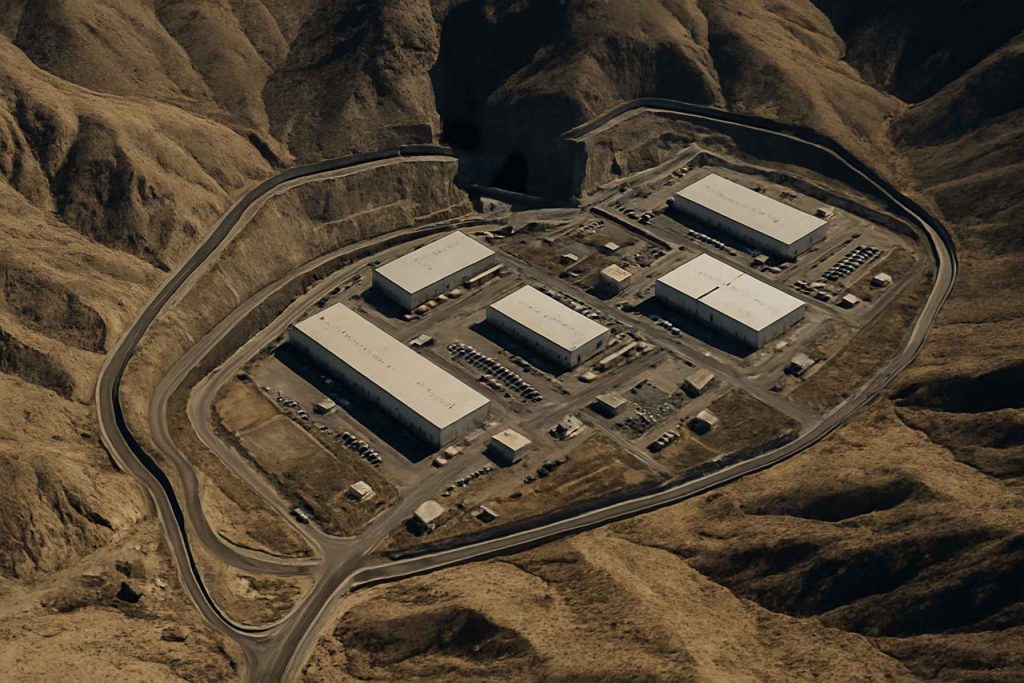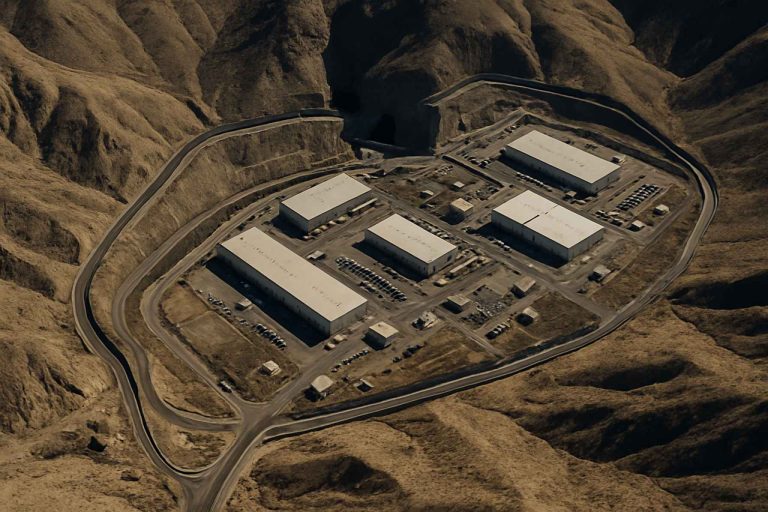
Inside Fordow: How Explosive Satellite Evidence Exposed Iran’s Nuclear Gambit and Sparked a High-Stakes U.S. Confrontation
- Global Context and Strategic Importance of Iran’s Nuclear Developments
- Advancements in Satellite Surveillance and Nuclear Detection
- Key Players and Stakeholders in the Iran Nuclear Standoff
- Projected Escalations and Diplomatic Shifts in Nuclear Monitoring
- Middle East Dynamics and International Reactions to Fordow’s Activities
- Potential Scenarios for Iran’s Nuclear Program and Global Security
- Risks, Diplomatic Hurdles, and Leverage Points in the Nuclear Dispute
- Sources & References
“South Korea is often hailed as a broadband utopia – and for good reason.” (source)
Global Context and Strategic Importance of Iran’s Nuclear Developments
Recent explosive satellite imagery has brought renewed global attention to Iran’s Fordow Fuel Enrichment Plant, a fortified nuclear facility buried deep within a mountain near Qom. In the days leading up to heightened U.S.-Iran tensions in early 2024, commercial satellites captured unusual activity at Fordow, including increased vehicle movement, construction work, and the apparent installation of new infrastructure. These developments have raised alarms among Western intelligence agencies and the International Atomic Energy Agency (IAEA), fueling speculation about Iran’s intentions and the potential acceleration of its nuclear program (Reuters).
The Fordow facility is of particular strategic concern because it is designed to withstand airstrikes and is capable of enriching uranium to weapons-grade levels. According to the IAEA’s May 2024 report, Iran has expanded its enrichment capacity at Fordow, now operating advanced IR-6 centrifuges and producing uranium enriched up to 60% purity—just short of the 90% required for nuclear weapons (IAEA). This escalation comes amid stalled diplomatic efforts to revive the Joint Comprehensive Plan of Action (JCPOA), with Iran reducing cooperation with inspectors and limiting access to key sites.
The timing of these secretive moves is critical. In April 2024, the U.S. reportedly considered military options in response to Iran’s regional activities and nuclear advances, prompting fears of a direct confrontation. The Fordow revelations have intensified calls from U.S. and European officials for renewed pressure and possible sanctions, while Israel has reiterated its willingness to act unilaterally if necessary (The New York Times).
- Global Stakes: Iran’s nuclear trajectory at Fordow is a flashpoint for regional security, with potential to trigger a broader conflict in the Middle East.
- Strategic Calculations: The U.S. and its allies must weigh the risks of military intervention against the dangers of a nuclear-armed Iran.
- Diplomatic Impasse: The lack of progress on the JCPOA and Iran’s increasing opacity complicate efforts to contain its nuclear ambitions.
In summary, the latest satellite images of Fordow underscore the high-stakes nature of Iran’s nuclear future, with global powers facing urgent decisions as the window for diplomatic resolution narrows.
Advancements in Satellite Surveillance and Nuclear Detection
Recent advancements in satellite surveillance have dramatically enhanced the world’s ability to monitor nuclear activities, with Iran’s Fordow Fuel Enrichment Plant emerging as a focal point in the ongoing standoff over its nuclear ambitions. In early 2024, high-resolution commercial satellite imagery captured by firms such as Planet Labs and Maxar Technologies revealed a flurry of construction and unusual activity at the Fordow site, located deep within a mountain near Qom. These images, analyzed by independent experts and intelligence agencies, showed new tunnel entrances, heavy machinery, and expanded infrastructure—signs interpreted as preparations to shield nuclear operations from potential airstrikes.
Fordow’s strategic significance lies in its fortified design and its role in uranium enrichment. The International Atomic Energy Agency (IAEA) reported in June 2024 that Iran had enriched uranium to levels just below weapons-grade at Fordow, intensifying international scrutiny. Satellite images provided crucial, near-real-time evidence of these developments, supplementing on-the-ground inspections and enabling rapid policy responses from the U.S. and its allies.
These revelations came at a critical juncture, as the U.S. weighed military options to deter further Iranian nuclear advances. The ability to detect and interpret subtle changes—such as the movement of earth, installation of air defenses, or the arrival of specialized vehicles—has become a cornerstone of modern nuclear monitoring. According to The New York Times, the Biden administration relied heavily on satellite intelligence to assess Iran’s intentions and calibrate its diplomatic and military posture.
- Enhanced Resolution: Modern satellites can now capture images with resolutions as fine as 30 centimeters, allowing analysts to identify individual vehicles and construction equipment.
- Rapid Revisit Rates: Constellations of small satellites provide daily, sometimes hourly, updates, reducing the risk of missing critical developments.
- AI-Powered Analysis: Machine learning algorithms sift through vast image datasets, flagging anomalies and accelerating threat detection (Reuters).
In summary, the fusion of advanced satellite imagery and AI-driven analysis has transformed nuclear verification, making clandestine moves at sites like Fordow far harder to conceal and raising the stakes in the high-stakes contest over Iran’s nuclear future.
Key Players and Stakeholders in the Iran Nuclear Standoff
Recent explosive satellite imagery has brought renewed global attention to Iran’s Fordow Fuel Enrichment Plant, a fortified nuclear facility buried deep within a mountain near Qom. In early 2024, high-resolution images from commercial satellites revealed unusual construction activity and increased movement of materials and personnel at Fordow, sparking concerns among international observers and intelligence agencies. These developments come amid escalating tensions between Iran and the United States, with speculation mounting over potential preemptive strikes and the future of Iran’s nuclear ambitions.
- Iranian Government and Atomic Energy Organization of Iran (AEOI): The AEOI oversees all nuclear activities in Iran, including enrichment at Fordow. Iranian officials maintain that their nuclear program is for peaceful purposes, but the recent satellite images—showing new tunnel entrances and expanded infrastructure—have raised suspicions about possible preparations for higher-level uranium enrichment or even weaponization (Reuters).
- United States Government and Intelligence Agencies: The U.S. has long viewed Fordow as a critical flashpoint. The Biden administration, while pursuing diplomatic avenues, has not ruled out military options if Iran crosses certain nuclear thresholds. The release of satellite images has intensified debates within the U.S. about the timing and necessity of a potential strike (The New York Times).
- International Atomic Energy Agency (IAEA): The IAEA is responsible for monitoring Iran’s compliance with nuclear agreements. Inspectors have faced increasing restrictions, and the new satellite evidence has prompted urgent calls for renewed access and transparency at Fordow (IAEA).
- Israel and Regional Allies: Israel considers Iran’s nuclear program an existential threat and has repeatedly signaled its willingness to act unilaterally. The Fordow revelations have heightened Israeli concerns and could accelerate contingency planning for direct action (Times of Israel).
- Global Stakeholders: The European Union, Russia, and China remain invested in diplomatic solutions, but the Fordow developments have complicated efforts to revive the Joint Comprehensive Plan of Action (JCPOA) and maintain regional stability.
As the world scrutinizes Fordow’s secretive moves, the high-stakes showdown over Iran’s nuclear future is entering a volatile new phase, with satellite intelligence playing a pivotal role in shaping international responses.
Projected Escalations and Diplomatic Shifts in Nuclear Monitoring
Recent high-resolution satellite imagery has brought renewed global attention to Iran’s Fordow Fuel Enrichment Plant, intensifying concerns over the nation’s nuclear ambitions and the potential for military escalation. In early 2024, commercial satellites captured unusual construction activity and increased security measures at the Fordow site, located deep within a mountain near Qom. Analysts from the International Atomic Energy Agency (IAEA) and independent research groups such as NTI have confirmed that these developments coincide with Iran’s recent enrichment of uranium to near-weapons-grade levels, a move that has alarmed Western powers.
According to a June 2024 IAEA report, Iran’s stockpile of uranium enriched up to 60% purity has reached approximately 121.6 kg, a quantity that, if further enriched, could be sufficient for several nuclear weapons (Reuters). The satellite images, analyzed by CSIS, reveal new tunnel entrances, expanded air defenses, and reinforced infrastructure, suggesting preparations for both continued enrichment and potential military strikes.
These revelations have triggered a flurry of diplomatic activity. The United States, citing the images and IAEA findings, has intensified calls for snapback sanctions and warned of “all options on the table” should Iran cross the nuclear threshold. Meanwhile, European signatories to the Joint Comprehensive Plan of Action (JCPOA) have urged restraint, but are reportedly preparing contingency plans in case of a U.S. or Israeli strike on Fordow (Politico).
- Escalation Risks: The exposure of Fordow’s secretive activities has heightened the risk of preemptive military action, with U.S. officials reportedly reviewing strike options and Israel reiterating its red lines (Times of Israel).
- Diplomatic Shifts: The IAEA Board of Governors is considering a formal censure of Iran, while Russia and China have called for renewed negotiations, highlighting deepening rifts within the UN Security Council.
- Regional Fallout: Gulf states are quietly bolstering missile defenses and seeking security assurances from Washington, fearing spillover from any direct confrontation.
In sum, the explosive satellite revelations at Fordow have not only exposed Iran’s nuclear advances but also set the stage for a high-stakes diplomatic and military showdown, with global nonproliferation efforts hanging in the balance.
Middle East Dynamics and International Reactions to Fordow’s Activities
Recent satellite imagery has brought renewed global attention to Iran’s Fordow Fuel Enrichment Plant, a fortified nuclear facility buried deep within a mountain near Qom. In the days leading up to the U.S. strike on Iranian targets in early 2024, high-resolution images from commercial satellites revealed unusual activity at Fordow, including increased vehicle movement, construction work, and what analysts interpreted as possible efforts to harden the site against potential attacks (Reuters).
These revelations have intensified the already volatile dynamics in the Middle East. Regional powers such as Israel and Saudi Arabia have long viewed Fordow as a red line, given its capacity to enrich uranium to near-weapons grade. Israeli officials, citing the new satellite evidence, reiterated their willingness to act unilaterally if Iran crosses certain nuclear thresholds (Times of Israel). Saudi Arabia, meanwhile, has accelerated its own nuclear ambitions, warning that unchecked Iranian advances could trigger a regional arms race (Al Jazeera).
Internationally, the United States and European Union have responded with a mix of diplomatic pressure and threats of renewed sanctions. The International Atomic Energy Agency (IAEA) confirmed that Iran had made modifications to Fordow’s centrifuge cascades, potentially enabling faster enrichment to higher levels (IAEA). The U.S. State Department called the developments “deeply concerning,” emphasizing that any further escalation could jeopardize prospects for renewed nuclear negotiations (U.S. State Department).
- Regional Security: The Fordow revelations have heightened fears of a direct military confrontation, with U.S. forces in the region placed on high alert.
- Diplomatic Fallout: European leaders have urged restraint, but divisions persist over how to balance pressure and engagement with Tehran.
- Global Markets: Oil prices spiked briefly in response to the satellite images and subsequent U.S. strike, reflecting market anxiety over potential supply disruptions (CNBC).
In sum, the explosive satellite revelations at Fordow have escalated the high-stakes showdown over Iran’s nuclear future, with profound implications for regional stability and international security.
Potential Scenarios for Iran’s Nuclear Program and Global Security
Recent satellite imagery has intensified global scrutiny of Iran’s Fordow Fuel Enrichment Plant, a fortified nuclear facility buried deep within a mountain near Qom. In early 2024, high-resolution images from commercial satellites revealed unusual construction activity and increased movement of materials and personnel at Fordow, sparking concerns among Western intelligence agencies and the International Atomic Energy Agency (IAEA) about possible covert nuclear advancements (Reuters).
These revelations come amid escalating tensions between Iran and the United States. In January 2024, the IAEA reported that Iran had expanded its uranium enrichment at Fordow, operating advanced IR-6 centrifuges and enriching uranium to 60% purity—just short of weapons-grade levels (IAEA). The timing of the satellite images, showing new tunnel entrances and reinforced structures, coincided with U.S. warnings of potential military action should Iran cross the nuclear threshold.
- Scenario 1: Diplomatic De-escalation – The exposure of Fordow’s activities could prompt renewed negotiations, possibly reviving elements of the 2015 Joint Comprehensive Plan of Action (JCPOA). However, trust deficits and regional instability make this path uncertain.
- Scenario 2: Covert Sabotage or Cyber Operations – The U.S. and its allies may intensify covert efforts to disrupt Iran’s nuclear progress, as seen in past incidents like the Stuxnet cyberattack. Such actions risk Iranian retaliation and further destabilization.
- Scenario 3: Preemptive Military Strike – If intelligence suggests imminent weaponization, the U.S. or Israel could launch targeted strikes on Fordow. Given the facility’s hardened defenses, this would be a high-risk operation with unpredictable regional consequences (BBC).
- Scenario 4: Accelerated Nuclear Breakout – Iran may exploit the standoff to rapidly achieve nuclear weapons capability, betting that international response will be delayed or divided. This would dramatically alter the security calculus in the Middle East and beyond.
The latest satellite revelations underscore the high-stakes nature of the current standoff. As Fordow’s secretive moves come to light, the world faces a volatile mix of diplomatic, military, and technological challenges that will shape the future of nuclear nonproliferation and regional security.
Risks, Diplomatic Hurdles, and Leverage Points in the Nuclear Dispute
Recent explosive satellite imagery has intensified scrutiny of Iran’s Fordow Fuel Enrichment Plant, a fortified nuclear facility buried deep within a mountain near Qom. In early 2024, commercial satellites captured unusual construction activity and increased vehicle movement at Fordow, just days before the U.S. conducted precision strikes in response to regional escalations. Analysts from the Nuclear Threat Initiative and International Atomic Energy Agency (IAEA) have raised alarms that these developments may signal preparations for higher-level uranium enrichment or the concealment of sensitive equipment.
The Fordow site, originally declared to the IAEA in 2009, is designed to withstand airstrikes and has been a focal point of Western concerns due to its potential for rapid conversion to weapons-grade enrichment. The latest satellite images, analyzed by the Institute for Science and International Security, show new tunnel entrances and reinforced structures, suggesting Iran is bolstering its defenses and possibly expanding its enrichment capabilities. This comes as the IAEA reported in June 2024 that Iran’s stockpile of 60% enriched uranium—close to weapons-grade—has reached over 140 kg, enough for several nuclear devices if further enriched (Reuters).
- Risks: The clandestine activity at Fordow heightens the risk of miscalculation. Any perceived move toward weaponization could trigger preemptive military action by the U.S. or Israel, risking a broader regional conflict. The hardened nature of Fordow complicates strike options, raising the stakes for all parties involved.
- Diplomatic Hurdles: Iran’s refusal to grant full IAEA access and its recent expulsion of top inspectors have eroded trust (Al Jazeera). The U.S. and European powers face challenges in uniting a response, as Russia and China continue to shield Iran diplomatically at the UN Security Council.
- Leverage Points: Despite tensions, Iran’s economy remains vulnerable to sanctions, and its leadership seeks relief. The U.S. and EU can leverage economic incentives or threats of further isolation. Meanwhile, Iran uses its nuclear advances as bargaining chips, hoping to extract concessions while avoiding direct confrontation.
In sum, the latest satellite revelations at Fordow underscore the high-stakes brinkmanship defining Iran’s nuclear future, with each side maneuvering for advantage amid profound risks and diplomatic deadlock.
Sources & References
- Explosive Satellite Images Reveal Fordow’s Secret Moves Before U.S. Strike—Inside the High‑Stakes Showdown Over Iran’s Nuclear Future
- International Atomic Energy Agency (IAEA)
- The New York Times
- Planet Labs
- Maxar Technologies
- CSIS
- Politico
- Al Jazeera
- U.S. State Department
- CNBC
- BBC



